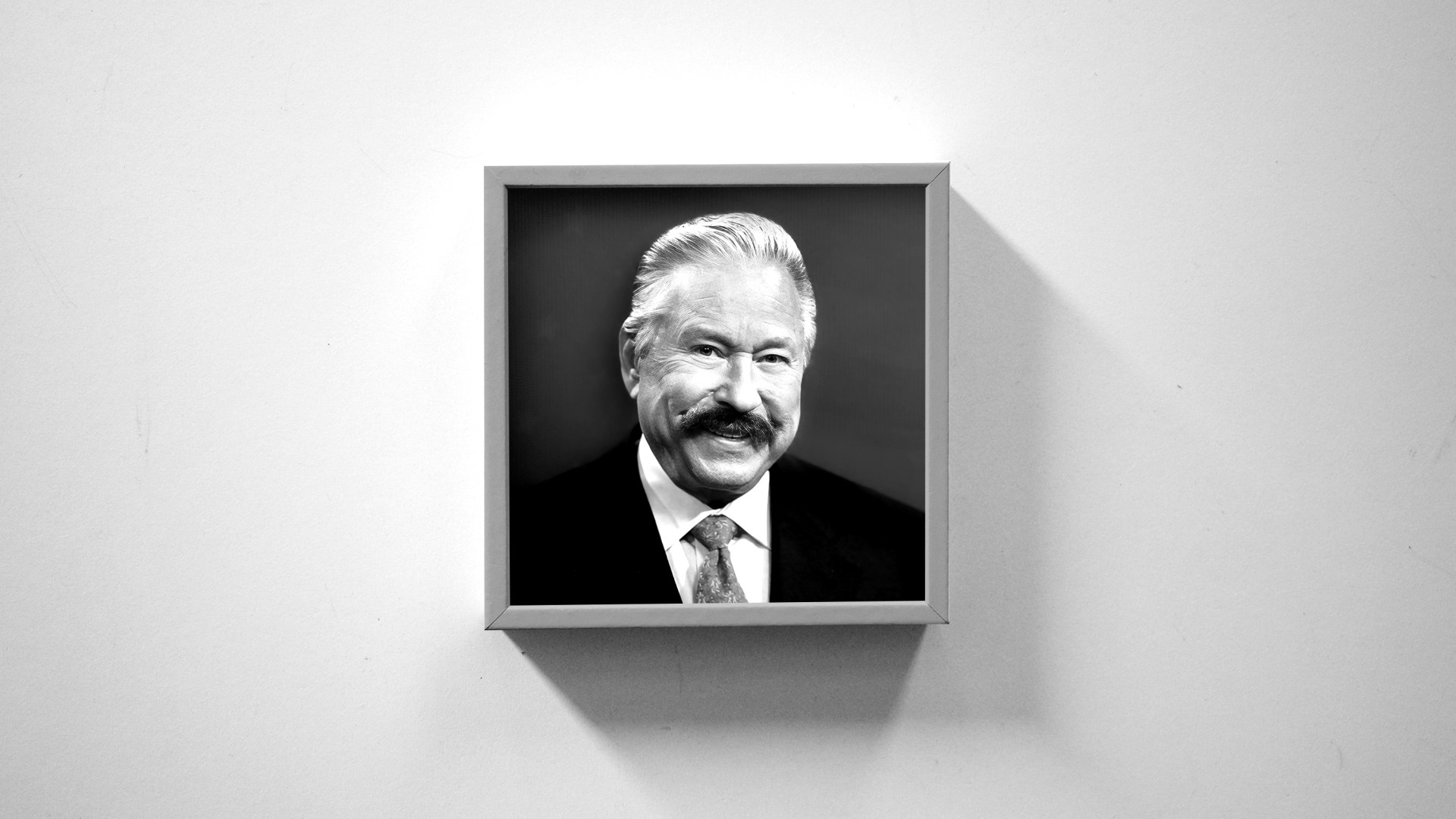Hal Lindsey, who popularized end times theology by connecting biblical prophecy to current and near-future events, died on November 25 at the age of 95.
Lindsey became a household name in America in the 1970s with the success of The Late Great Planet Earth, which he cowrote with journalist Carole C. Carlson. The book sold an estimated 35 million copies by the end of the century, and several follow-up titles, including Satan Is Alive and Well on Planet Earth and Planet Earth Two Thousand AD: Will Mankind Survive? were also bestsellers.
Lindsey’s books demonstrated an incredible appetite for apocalyptic speculation in America and paved the way for many other prophecy writers, including Tim LaHaye, Jerry Jenkins, and Joel Rosenberg. He brought the once-obscure theology of dispensationalist premillennialism into the mainstream, introducing wide audiences to the concepts of the Rapture, the Antichrist, and the mark of the beast.
Lindsey’s lasting legacy is perhaps most clearly seen in the way those ideas have been adopted and adapted with great flexibility, from critics of COVID-19 vaccines saying immunization might be the mark of the beast to Jewish comedians Seth Rogan and Evan Goldberg proving their film-writing talent with a Rapture movie.
Lindsey, for his part, believed applying Scripture to the “signs of the times” was the best way to demonstrate that Scripture was not only relevant to modern life but also urgent. The Bible had the answer to all of life’s questions, he said, including “What happens next?”
“There are other places men search for answers: philosophy, meditation, changing environment, science,” Lindsey and Carlson wrote in the opening of The Late Great Planet Earth. “Let’s give God a chance to present His view.”
Harold Lee “Hal” Lindsey was born in 1929 in Houston. He joined the US Coast Guard during the Korean War and served in New Orleans, where he worked as a tugboat captain. Though he attended church regularly, it was not until a near-death experience on the Mississippi River that Lindsey grew serious about his personal faith. In 1955, after meeting with a prominent Houston pastor, Robert Thieme of Berachah Church, Lindsey had a born-again experience. Faith became central to his life—and so did prophecy.
Thieme, who was called “the Colonel” by his congregation, was a self-described fundamentalist and an avid proponent of the theological system called dispensationalism. To understand the Bible, dispensationalism said, one had to see how God related to people differently in different historic epochs.
The interpretive approach was developed in 19th century prophecy conferences and the fundamentalist movement in the early 20th century. It was codified with the Scofield Reference Bible, compiled by Cyrus I. Scofield and published by Oxford University Press in 1909. Notes in the Scofield Bible explained to readers that God had two chosen peoples: the Jewish people, known as Israel, and the church. The former would fulfill God’s earthly plans while the latter, made up of gentiles, would reign with God in heaven.
Lindsey studied this approach to Scripture with Thieme and then went to Dallas Theological Seminary, a center of dispensationalist theology. He graduated in 1962 with a degree in Greek New Testament.
After seminary, he joined Campus Crusade for Christ (now Cru) and moved to the University of California, Los Angeles, to evangelize students. He started a Bible study focused on prophecy. Week by week, Lindsey spoke about current crises facing baby boomers, including the war in Vietnam, protests, riots, the exploding counterculture, conflict in the Middle East, and the threat of nuclear war. He told the students it was all predicted by the Bible.
“We are able to see … predictions made centuries ago being fulfilled before our eyes,” Lindsey explained. “A person can be given a secure and yet exciting view of his destiny by making an honest investigation of the tested truths of Bible prophecy.”
The Bible studies became wildly popular, drawing both skeptical college kids who were nonetheless curious about the future fate of the world and young Christians who were thrilled by the way Lindsey could make the Bible seem relevant.
“I recall, almost wistfully, the sense of excitement, intensity, and urgency we felt as Hal linked the Scripture to our world, our dilemmas, our questions,” wrote Chris Hall, a theology professor who attended Lindsey’s Bible studies as an undergraduate. “As Hal interpreted apocalyptic images from Daniel and Revelation, a new world opened up—a world that God controlled, even in its worst moments, and promised both to redeem and judge.”
After six years, however, Lindsey’s success became a problem for Campus Crusade. Founder Bill Bright worried the group was becoming too closely associated with what he called a “particular theological hobbyhorse.”
Lindsey decided to start his own ministry, the Jesus Christ Light and Power Company. Headquartered in a former frat house at the edge of the UCLA campus, he continued to hold popular weekly Bible studies that invariably connected Scripture and current events.
His teaching reached a wider audience in 1970, when Zondervan, at the time a small Christian publisher, released The Late Great Planet Earth. The book, cowritten with Carlson, sold 500,000 copies within a few years.
It was successful enough that Bantam Books, a mainstream publisher, picked up options for a mass-market paperback. Bantam released its edition in 1971 and sold it in hundreds of thousands of locations across the US—at newsstands, bus stations, airports, and supermarkets, not to mention bookstores—right alongside other popular paperbacks, including The Exorcist, East of Eden, The Catcher in the Rye, the Warren Commission report on the assassination of president John F. Kennedy, fiction about sex in the counterculture, and Agatha Christie novels.
The Late Great Planet Earth sold more than 10 million copies before the end of the 1970s, becoming the best-selling nonfiction book of the decade.
Lindsey’s vision of the approaching apocalypse was not innovative, even though his style was intended to reach baby boomers in their early adulthood. He stuck to the accepted dispensationalist timeline for the unfolding of biblical prophecy. Before the return of Christ, he said, four prophetic events had to be fulfilled. Three of them involved the Jewish people: They needed to return to their land, recapture Jerusalem, and rebuild the temple destroyed by Roman legions in the year 70. The fourth involved Christians and could happen at any moment: the Rapture.
With the establishment of the state of Israel in 1948 and the victory in the Arab-Israeli War in 1967, when the Jewish people took Jerusalem, two of the four steps had been fulfilled, indicating the end was in fact quite near.
Lindsey had a popular touch that his dispensationalist teachers at Dallas Seminary lacked. Where most dispensationalist writing had been technical and byzantine, Lindsey jettisoned the old jargon and adopted the easy style of the baby boomers. He called the rapture “the ultimate trip” and dubbed the Antichrist the “Future Fuhrer.”
“We have been described as the ‘searching generation,’” he explained, including himself in the group born two and three decades after him. “We need so many answers—answers to the larger problems of the world, answers to the conditions in our nation, and most of all, answers for ourselves.”
Lindsey realized prophecy preaching could have mass appeal, and he was right. After the success of the paperback, The Late Great Planet Earth was made into a television series and a film narrated by the legendary director Orson Welles.
Lindsey accrued a fortune with his book sales, media appearances, and multimedia products. In 1977, Publisher’s Weekly described him as “an Adventist-and-Apocalypse evangelist who sports a Porsche racing jacket and tools around Los Angeles in a Mercedes 450 SI.” In 1981, the Los Angeles Times reported that Lindsey was making “thousands of dollars a week” from combined sales of books, films, and cassette tapes. He also kept up a busy schedule of public speaking and consulting, meeting with low- and mid-level government officials around the globe to advise them on the future.
During the 1970s, Lindsey became convinced he should support politicians who would prepare the United States for what was to come. In The 1980’s: Countdown to Armageddon, he urged his Christian readers to support the US military buildup, including the expansion of America’s nuclear arsenal, while also opposing big government at home. The book, published with Bantam, sold 360,000 copies in 1980 and held a spot on The New York Times bestseller list for 20 weeks that election year. When Ronald Reagan entered the White House, administration officials made sure that Lindsey knew he had their ear.
In the midst of his professional success, Lindsey’s personal life suffered. His first marriage failed around the time of his conversion. He got divorced and remarried to Jan Houghton, who worked alongside him at Campus Crusade and appeared with Lindsey in author photos until the mid-1980s, when an updated edition of Late Great Planet Earth used a different picture and removed her name from the dedication.
Lindsey’s second divorce—and subsequent third and fourth marriages—raised questions about his character for many evangelicals. But the biggest blow to his reputation was his failed predictions.
In his early books, Lindsey said all of the Bible’s prophecy would likely be fulfilled “within forty years or so of 1948,” when the nation of Israel was founded, based on his typological reading of Matthew 24. He qualified his prediction, giving himself an escape hatch with phrases like “or so.” But few readers came away with the impression that Lindsey was unsure whether Christ would return by 1988.
CT asked Lindsey about the risk of failed predictions when he published The Terminal Generation.
“There’s just a split second’s difference between a hero and a bum,” Lindsey said. “I didn’t ask to be a hero, but I guess I have become one in the Christian community. So I accept it. But if I’m wrong about this, I guess I’ll become a bum.”
When 1988 came and went and the Soviet Union, one of the main objects of dispensational analyses, ultimately collapsed, Lindsey was forced to defend himself and his end times speculation. He directed his book The Road to Holocaust at evangelicals and fellow conservatives in 1989, making the case for the continued relevance of dispensationalist interpretations of Scripture and current events.
While he was dismissed and marginalized by many evangelicals, Lindsey continued to see commercial success. Retooling his analysis for a post–Cold War geopolitics, he returned to bestseller lists with Planet Earth Two Thousand AD: Will Mankind Survive? in 1994.
That same year, Lindsey began the prophecy-oriented television news show International Intelligence Briefing, which eventually found a home on the Trinity Broadcasting Network. The show was renamed The Hal Lindsey Report in 2007.
Lindsey continued offering commentary on current events, connecting them to biblical prophecy, until a few months before his death. The fall of the Soviet Union; the terrorist attacks on September 11, 2001; and the war on terror all prompted him to reevaluate his interpretations of prophecy, a process he seemed to relish. He spoke about the 2024 election and Israel’s war with Hamas.
“Remember that all this was foretold by the prophets, and it leads to something wonderful—the return of Jesus,” Lindsey said. “So, stay faithful. Continue to pray for the peace of Jerusalem. Draw especially close to the Lord and His Word in this hour. Spread the good news of God’s amazing salvation.”
Lindsey is survived by his three daughters from his second marriage, Robin, Heidi, and Jenny, and his wife JoLyn.



















































